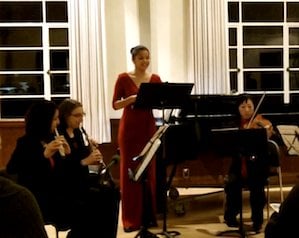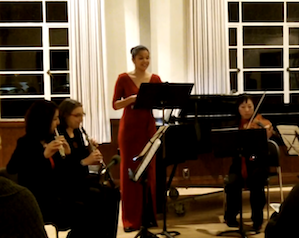
The idea of “pluralism,” meaning a bewildering mix of musical styles, is often used to describe contemporary music. By including a wide range of composers and avoiding any particular programmatic theme, the second concert of the 12th annual Festival of Contemporary Music seemed deliberately to embody this idea. In its Saturday concert at the Community Music Center in San Francisco’s Mission District, Festival directors Brian Bice, John Bilotta, and Davide Verotta constructed a diverse program by showcasing no fewer than six composers.
Despite all the variations in musical style heard there, having performers recur offered some continuity. Andrew White, an outstanding and thoughtful baritone, performed three pieces. He opened the evening with Random Blackouts I (Image Music XXXIII), a composition by Greg Steinke for voice and four-hand piano. The work consists of seven brief songs. If any single song were considered in isolation, its lyrics might seem amusing. For example, “Ages of trees [are] authorized by rings” and “No, I cannot walk to the grocery; people might recognize me.” In tandem, though, the seven songs ruminate more profoundly on the threat of ecological collapse in light of humankind’s unique consciousness that our civilization’s days are possibly (inevitably?) drawing to a close.
White’s voice also opened the program’s second half with an unaccompanied piece by William Vollinger, Stalin and the Little Girl (An Icon). Joining him on stage was a large print of the titular photograph, which shows Joseph Stalin holding a smiling little girl. It turns out that her father was later shot by Stalin’s regime because he was believed to have been a Japanese spy, and her mother also died under suspicious circumstances. After their deaths, the photo continued to be used as a propagandistic tool, whereas facts about their deaths were suppressed.
Vollinger describes his piece as a “dramatic monologue” depicting what the composer imagines the dictator’s own conflicted thoughts and feelings about the matter may have been. As the composer puts it, “The music is confined to unaccompanied voice expressing his isolation, using a variety of devices and word settings to articulate his guilt and torment.” White’s performance was compelling indeed.
In the third song, “The Cat and the Moon,” Rickard musically emphasized the playful ephemerality of the poem’s cat versus the austere permanence of its moon.
The final work featuring White was the premiere of Sylvia Rickard’s 3 Yeats Songs. Rickard explained to me that she set poems by William Butler Yeats because he’s one of her favorite poets, and the number 3 was symbolically significant because she wrote the work in honor of a beloved friend who died at the age of 93. In the third song, “The Cat and the Moon,” Rickard musically emphasized the playful ephemerality of the poem’s cat versus the austere permanence of its moon.
Another work featuring Anglophone poetry that elegiacally juxtaposes the pain of mortal life with the hope of enduring nature was John Bilotta’s The Song of the Hermit Thrush. It sets the “Death Carol” from the 14th canto in Walt Whitman’s epic When Lilacs in the Dooryard Bloom’d: “Come lovely and soothing death . . . I float this carol with joy, with joy to thee O death.” The piece is scored for soprano and a quintet of flute, oboe, violin, viola, and cello. Sarita Cannon’s captivating voice floated above the ensemble with such calm clarity that it seemed perfectly to embody the “strong Deliveress” of Whitman’s poem. More simply: Cannon’s voice is just gorgeous, and it made Bilotta’s work my personal favorite of the evening.
Sarita Cannon’s captivating voice floated above the ensemble with such calm clarity that it seemed perfectly to embody the “strong Deliveress” of Whitman’s poem.
Rounding out the program were two instrumental pieces, neither of which instantiate “purely instrumental” or “absolute” music. Instead, both fall somewhere between character and program music, meaning that they’re associated with extramusical ideas. Daniel Godsil describes his Zed One Three — a trio for violin, cello, and piano — as “an experiment in science-fiction-inspired musical narrative” in which “a group of stoic Explorers discovers an ancient Device floating deep in the Void.” I have no idea what any of this means, but I did note that the music is made up of discrete sections that contrast with one another and that nevertheless have an intensity that seems amenable to a dramatic narrative.
Closing the concert was a piano sonata by Leslie La Barre, a California native who is currently a D.M.A. candidate at Claremont College. Her sonata is in three movements, each associated with a Roman deity. Musically, all three seem to experiment with open-fifth intervals. Emily Tian performed the piece with the same concentrated energy that also characterized her earlier collaborative performances with Andrew White.
All told, the range of musical styles made this program pluralistic indeed. Nonetheless, it was consistently interesting, which bodes well for the Festival’s third and final concert on August 30 at the Center for New Music in San Francisco.

